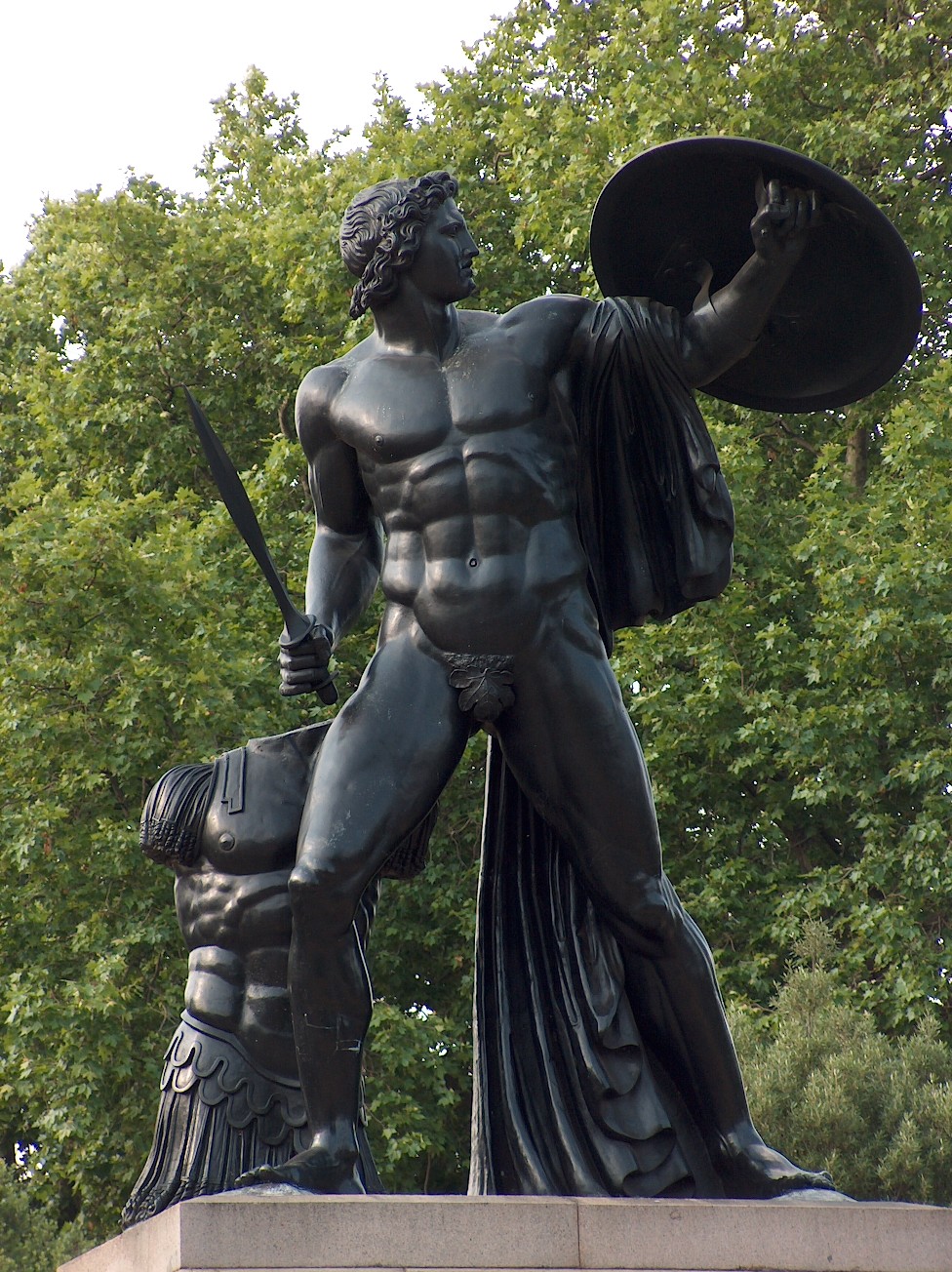Renaissance & Baroque Art
It was well-known to the painters of the Renaissance and Baroque that the Jewish characters of the Old and New Testaments were circumcised. The Feast of the Circumcision, January 1st, was an important part of the church year, and was often depicted in religious art, as shown below. Yet images of biblical characters were invariably depicted as uncircumcised. Further more, even older men were depicted with the classical small, phimotic penis even though the evidence suggests that their models would not have looked like that. The Graeco-Roman tradition still ruled!
Here are some examples:
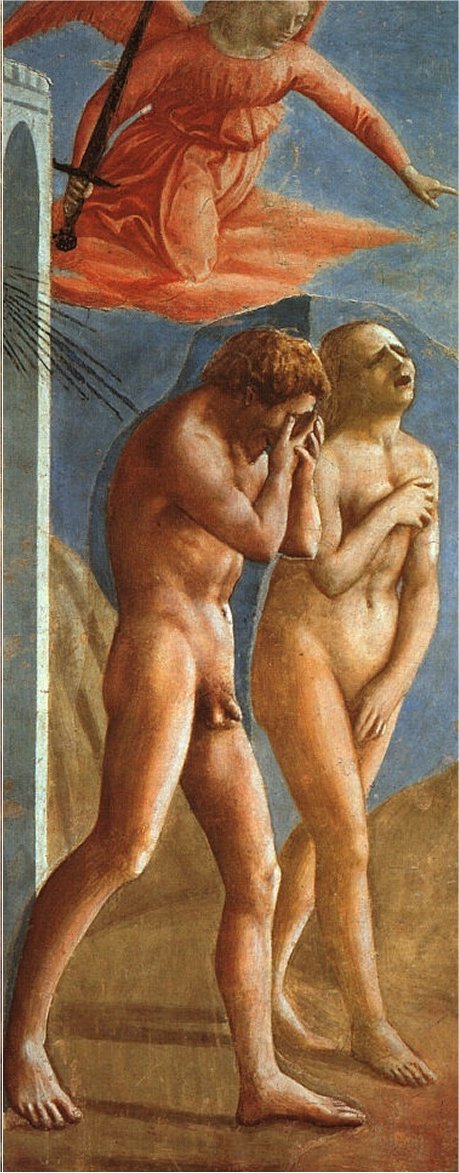 |
Tommaso di Ser Giovanni di Simone, known as Masaccio, 1401-1428
The expulsion from Eden, c. 1424.
Brancacci Chapel in the church of Santa Maria del Carmine in Florence.
This was one of the first nude paintings of the Italian Renaissance, and Masaccio was an early practioner of both realistic perspective and depictions of emotion. The latter is particularly evident here. Eve's attempts at modesty remind us of Botticelli's Birth of Venus, painted 60 years later, but the pose actually comes from a classical Greek sculpture, the Aphrodite of Cnidos - known to Masaccio by a Roman copy, the Capitoline Venus. Masaccio's tragically early death at age 26 (cause unknown) was widely mourned by his contemporaries, who regarded him as one of the finest painters of the time.
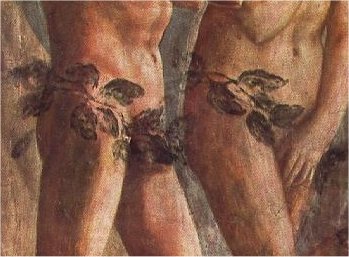  We are lucky to be able to see Adam's private parts - before cleaning in the 1980s they were hidden by added vegetation (not actually fig leaves), shown left. The angel's severe expression was also toned down (shown right) before the cleaning revealed Masaccio's original version.
We are lucky to be able to see Adam's private parts - before cleaning in the 1980s they were hidden by added vegetation (not actually fig leaves), shown left. The angel's severe expression was also toned down (shown right) before the cleaning revealed Masaccio's original version.
Images courtesy Wikimedia Commons. Thanks to JM for suggesting this painting.
 Click the image to enlarge. Use the Back button of your browser to return to this page. Click the image to enlarge. Use the Back button of your browser to return to this page.
|
Leonardo di ser Piero da Vinci (1452 – 1519)
Leonardo needs no introduction but this picture, the Madonna of the Carnation, is a bit of a surprise. It is in the Alte Pinakothek in Munich (the only Leonardo painting in Germany). It was painted around 1478-1480, perhaps when Leonardo was still working in Verocchio's studio. The blood-red carnation is regarded as symbolising Christ's eventual Passion. But the most striking feature is that the infant Jesus appears to be circumcised - the only example I know of a truthful depiction of those parts in a Renaissance painting (compare Caravaggio's version, below.) Thanks to contributor EW for bringing this to our attention.
 Click the image to enlarge. Use the Back button of your browser to return to this page. Click the image to enlarge. Use the Back button of your browser to return to this page.
|
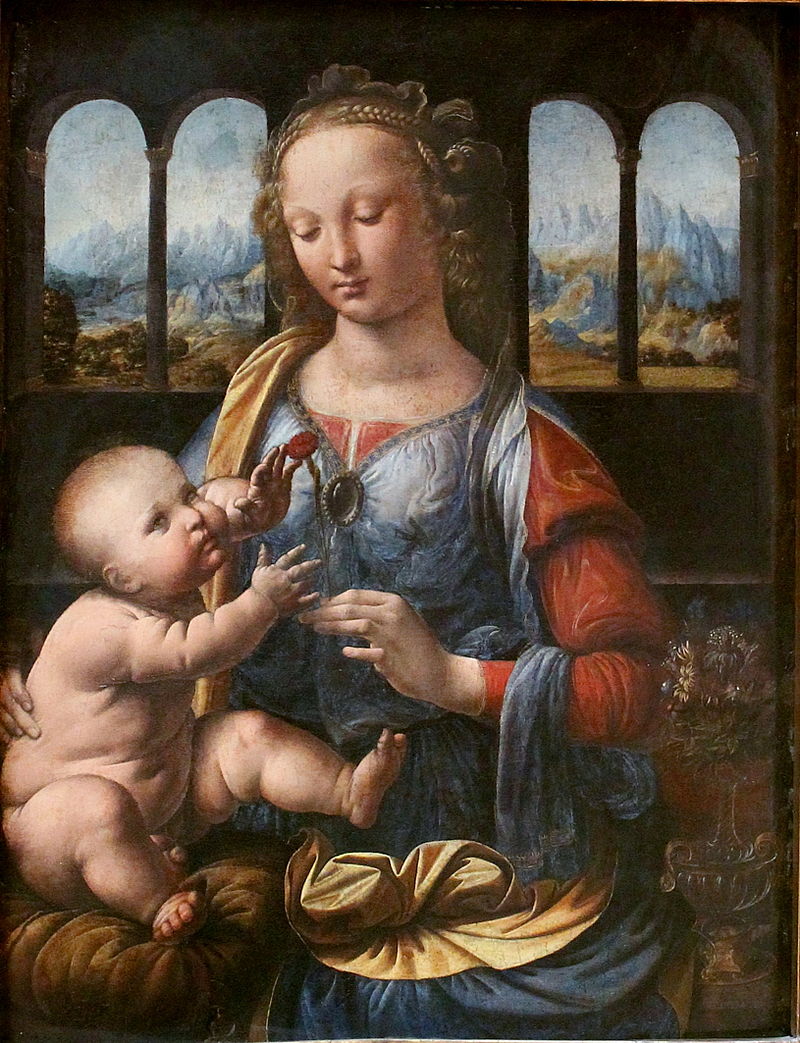 |
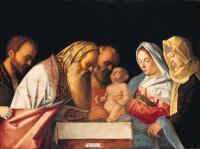 |
|
Giovanni Bellini (circa 1430‒1516)
The reluctance to depict a circumcised penis in classical art resulted in a tendency to obscure the genitals when the subject matter was biblical circumcision, as illustrated here in Bellini’s painting The Circumcision painted circa 1511.
This was a popular subject, and some pictures do show the penis pre-op, with a knife brandished above it, but neither the post-op view, or any blood, are ever visible. See our Christianity page.
 Click the image to enlarge. Use the Back button of your browser to return to this page. Click the image to enlarge. Use the Back button of your browser to return to this page. |
Michelangelo di Lodovico Buonarroti Simoni (1475‒1564)
Michelangelo was inspired by classical models, but he would certainly have used a live human as the basis for the statue of David which was sculpted 1501‒1504. However, the artist wouldn’t have expected him to pose for three years! Drawings would have been made which would have been the guides for the subsequent years of work. Most sculptors built clay maquettes ‒ small scale versions of their sculptures ‒ though legend says that Michelangelo often sculpted direct into stone without maquettes. This may not be true for the statue of David, though, since the block of Carrara marble was second hand and a peculiar shape (having been abandoned during ‘roughing out’ by a previous sculptor) so the statue had to be very carefully designed to fit the stone. Thus his model would have posed for a few days while Michaelangelo made drawings and (maybe) a maquette, then the long labour of transferring it to stone would have started.
 Click the image to enlarge. Use the Back button of your browser to return to this page. Click the image to enlarge. Use the Back button of your browser to return to this page. |

|
 |
|
Andrea d'Agnolo di Francesco di Luca di Paolo del Migliore
Known as Andrea del Sarto (born 1486 or 1487‒died 1530 or 1531)
The Sacrifice of Abraham by Andrea del Sarto was painted circa 1527, depicting the Biblical story found in Genesis 22:1-19. It shows Isaac as a boy of twelve or thirteen, who is not circumcised. The angel who stays Abraham’s hand is also a naked boy, much younger and also uncircumcised. Yet if anyone Isaac, as Abraham's first-born son after the adoption of the covenant of circumcision, should have been depicted as circumcised.
 Click the image to enlarge. Use the Back button of your browser to return to this page. Click the image to enlarge. Use the Back button of your browser to return to this page. |
Michelangelo Merisi da Caravaggio
Known as Caravaggio (1571‒1610)
The Caravaggio painting shown here, which is one of his finest masterpieces, depicts the Madonna and Child with St. Anne. It shows a naked, uncircumcised Jesus aged about 7 stepping on the head of a snake and was painted 1605-1606.
The history of this picture is amusing, and mirrors that of several others of his ecclesiastical works. The painting was commissioned by a church of St Anne, but the realistic portrayal of St Anne as an elderly lady was not acceptable to the church. He promptly sold it privately at a very good price and painted another picture for the church.
 Click the image to enlarge. Use the Back button of your browser to return to this page. Click the image to enlarge. Use the Back button of your browser to return to this page. |
|
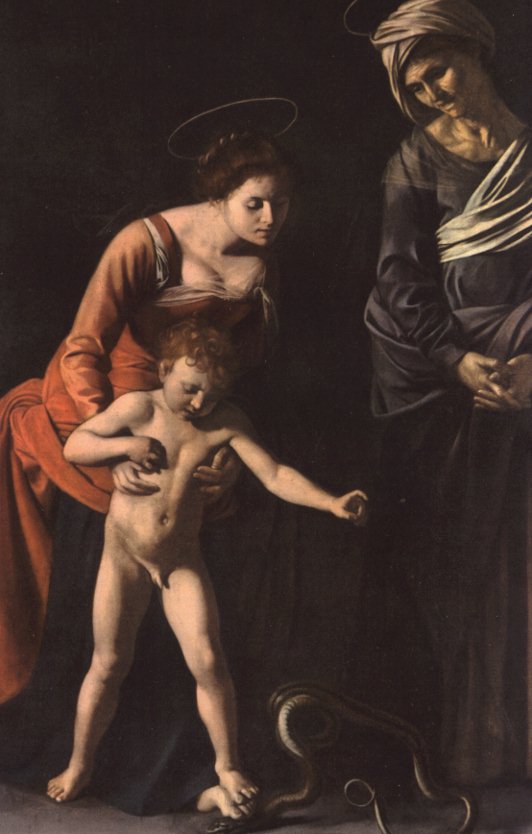 |
Eighteenth & Nineteenth Centuries
The 18th and 19th centuries were the age of the great academies. The concept started in France back in 1648, when Louis XIV gave royal assent to the foundation of the Académie de peinture et de sculpture. Other European countries gradually followed, and eventually Britain followed suit with the Royal Academy, founded in 1768. These academies had two functions. Firstly, they sought to replace the master-apprentice system under which all artists had formerly been trained, with a formal system of instruction. Secondly, they provided exhibitions where artists could show their work. The old system where artists were patronized by great houses was dwindling, but the rising wealthy middle class were seeking art to decorate their homes and reflect their standing in society. Public exhibitions were essential for this.
The teaching methods were rigorous, and totally different from the old apprenticeship approach. You copied the Old Masters, and you had to prove your ability drawing statuary before being allowed to graduate to the Life Class. The European academies only had male models until the 19th century, but the Royal Academy employed female models from the outset. However there were four male models each week and only one female (perhaps because they paid the females twice as much as the men). Unmarried males under 20 were not admitted to the female life classes. So every artist saw, and drew, plenty of nude men. (For more about Royal Academy models read the interesting article Naked Truth.)
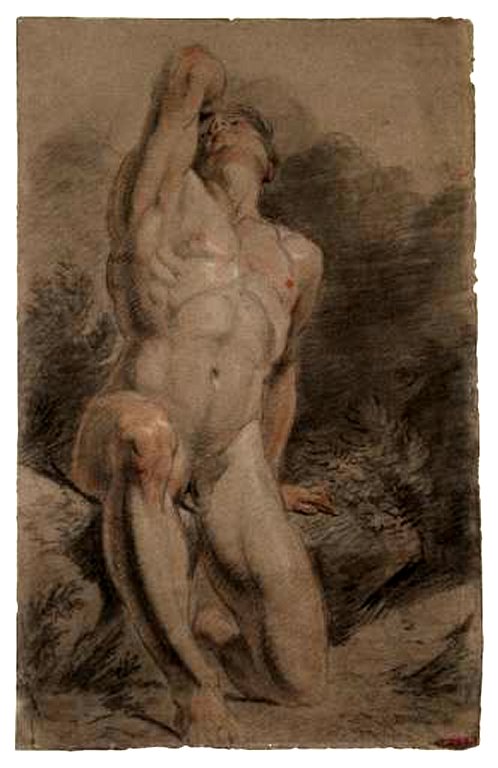
One of the early students in the Life Class was the painter JWM Turner, soon to become a hugely successful, and radical, figure in British art. Here is one of his life class sketches, worked up a bit to show a man in the countryside rather than the classroom. Turner was then just 15, and so forbidden to attend the female life classes.
Turner, kneeling man with hand upraised, around 1790, courtesy of the Tate Gallery, released under Creative Commons licence.
If you look closely, it is quite clear that the man is circumcised! The arrow in the detail image(below) points to the bare glans, with the coronal sulcus fully exposed.
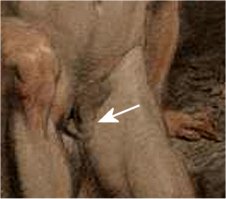
This is quite radical, and if Turner had used this figure in one of his oil paintings for public exhibition he would doubtless have made changes, but faced with a circumcised model he took the chance to capture the bare knob. It would seem that a circumcised penis, even if not the norm, wasn't such a rarity that a man would feel uncomfortable exposing it in a life-drawing class. It is most unlikely that he was Jewish, since nudity is taboo in Judaism. It is more likely that he had served in the British East India company, where circumcision was common (see our UK page.) His muscular build suggests at least a spell as a soldier. (The male models were mostly young porters, boxers or soldiers.)
Modern Art
Eugène Jansson (Sweden) 1862-1915
Jansson was a Swedish impressionist painter who specialized, initially, in landscapes and cityscapes. These sold well but by the early 20th century he was tired of these subjects. From 1904 to 1907 he exhibited nothing, but then exhibited again, now specialising in the male nude. Many paintings were of his younger lover, Knut Nyman. He also had the funds to afford a trip to Paris, which had been beyond his means as a young man. This painting, Garçon Nu (nude boy) presumably dates from this trip.
Is the boy circumcised? If so it predates Egon Schiele's painting, below, as the first 20th century painting of a circumcised male. There would have been no shortage of circumcised young men in Paris at that time, since Algeria and Morocco were then part of France. But I don't think this boy is circumcised since his glans is so purple - the colour usually lightens after circumcision. Just retracted, I think - that's still pretty radical for this date.
 Click the image to enlarge. Use the Back button of your browser to return to this page. Click the image to enlarge. Use the Back button of your browser to return to this page.
Picture contributed by MS.
| |
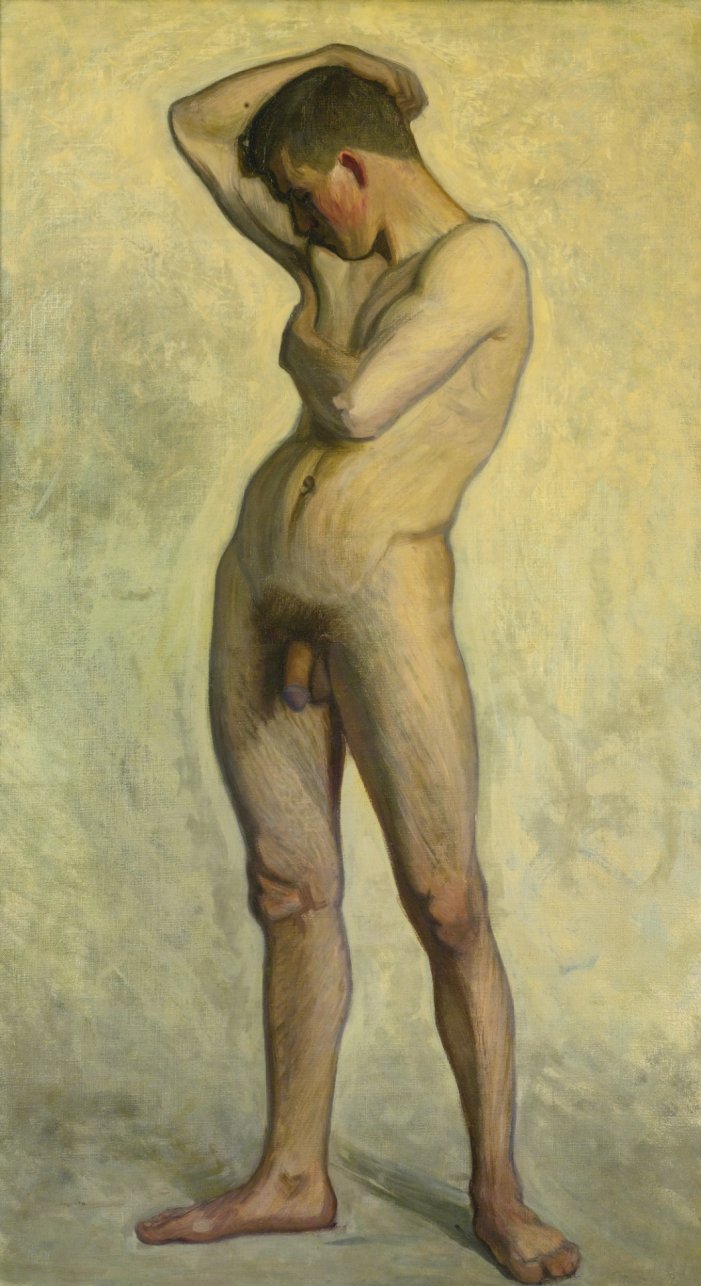 |
 | |
Egon Schiele (Austria) 1890-1918
From the 20th century on artists were more willing to depict their male figures as circumcised. This recent discovery, Male Nude, yellow, painted by Egon Schiele in 1910, takes the record for the earliest example from Augustus John (below). Schiele was notorious in his short lifetime for the sexually explicit nature of his pictures (which actually landed him 3 weeks in jail). This is not a self-portrait - Schiele drew nude self-portraits in which he clearly had a foreskin. Also, the roughly sketched head seems to have a flowing moustache blending into sideburns, while Schiele was clean shaven.
Austria did have a large Jewish population at this time but Judaism prohibits nudity, and the facial hair suggests a gentile rather than a Jew. We do have to suspect that circumcision was much more common at this period than some historians would have us believe.
 Click the image to enlarge. Use the Back button of your browser to return to this page. Click the image to enlarge. Use the Back button of your browser to return to this page.
 Click here to see a closeup of the genitals. Use the Back button of your browser to return to this page. Click here to see a closeup of the genitals. Use the Back button of your browser to return to this page.
Image courtesy of the online Artsy magazine.
|
Augustus John (UK) 1878-1961
The British artist Augustus John made this drawing sometime around 1920. He was in America for quite a while in the early '20s, so this is probably an American boy, the son of one of his patrons. His own sons, of whom he made many drawings, were not circumcised. He was very famous in the first half of the 20th century, mainly as a portraitist. He was also notorious for his personal life - one woman at a time was never enough for him!
|
|
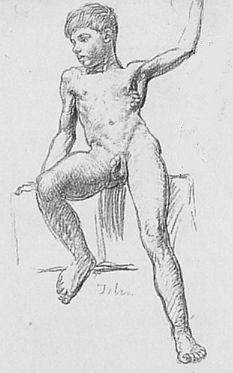 |
 |
Stanley Spencer (UK) 1891-1959
Sir Stanley Spencer (as he became) was a great, famous and very eccentric British artist. This picture 'Stanley Spencer and his second wife', popularly known as the 'Leg of Mutton' portrait, shows Spencer with his second wife, Patricia Preece. He had become infatuated with her in 1929 and finally married her, after divorce from his first wife Hilda Carline, in 1937. So why is he looking so gloomy in this portrait? Well, Patricia was a lesbian, and continued to live with her lover, artist Dorothy Hepworth. The marriage was never consummated. Meanwhile Spencer had made all of his property over to her. We can see, though, that Spencer had a tight circumcision - perhaps unusual for a boy born in 1891 in the UK.
Image courtesy Fitzwilliam Museum, Cambridge. Thanks to JM for proposing this page.
 Click the image to enlarge. Use the Back button of your browser to return to this page. Click the image to enlarge. Use the Back button of your browser to return to this page.
|
Alice Neel (USA) 1900-1984
was another who showed penises the way they were, or sometimes how she wanted them to be. Her 1933 painting Joe Gould (who she obviously thought was a bit of a prick) is shown with 3 penises, all uncircumcised, while beside him is the handsome torso of a circumcised man.
Her heirs are strict about copyright so we cannot reproduce her work here.
Paul Delvaux (Belgian) 1897-1994
Paul Delvaux was commonly called a surrealist though he wasn't happy with the label. A recurring theme in his work was a young boy or youth approaching an older woman, as in this picture, the Spitzner Museum, painted in 1943. The Spitzner Museum was a travelling exhibit of medical curiosities which Delvaux had seen 10 years previously. One booth showed real skeletons with a waxwork nude woman - which breathed! The woman's body could also be opened to reveal her internal organs. In this picture we see that the boy is quite thoroughly circumcised. Circumcision seems to have always been more commmon in Belgium than elsewhere in Europe, but it's perhaps a surprising theme when the country was under German occupation. For a larger scale detail image of just the boy and the woman click here.
 Click the image to enlarge. Use the Back button of your browser to return to this page. Click the image to enlarge. Use the Back button of your browser to return to this page.
|
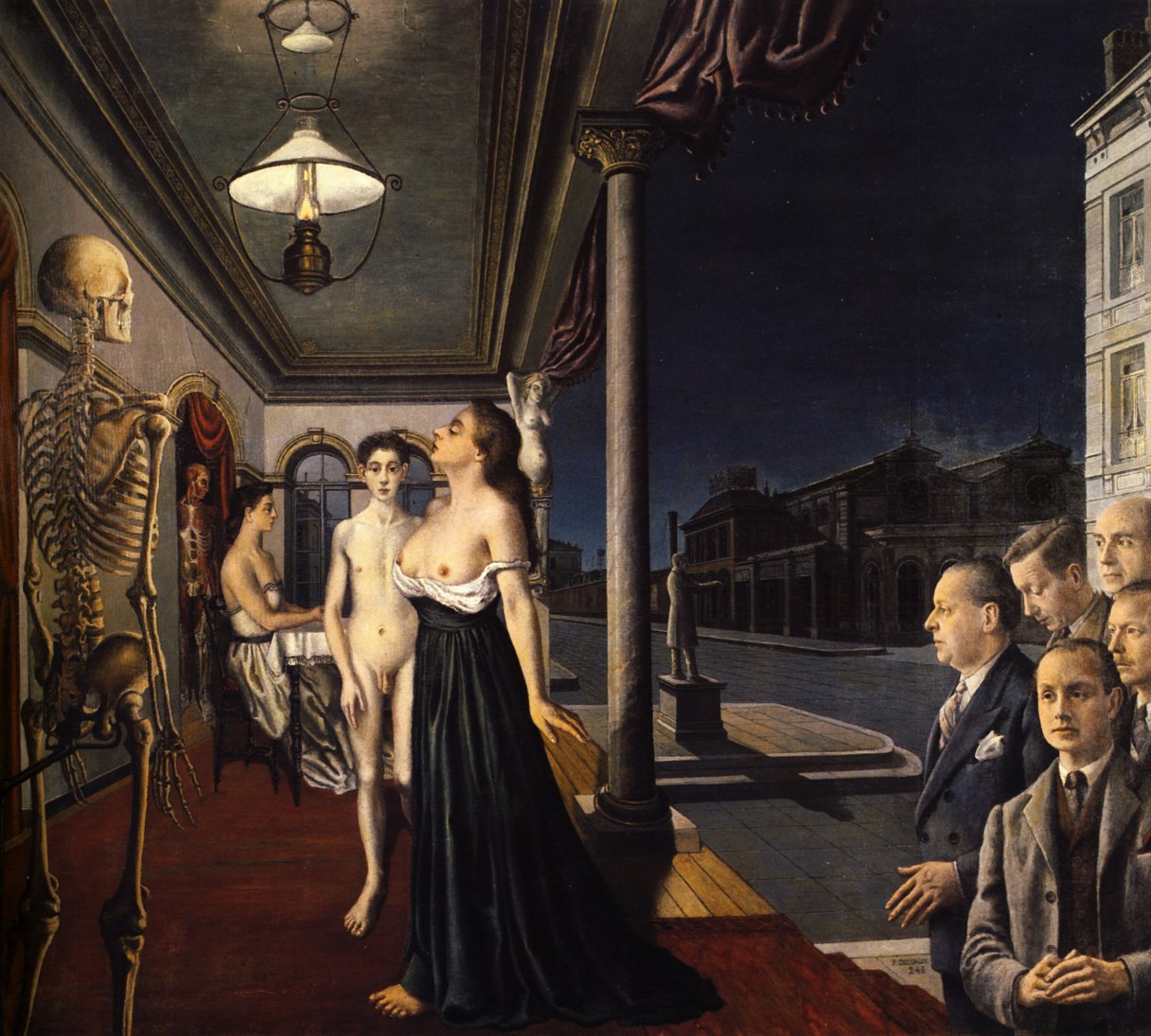 |
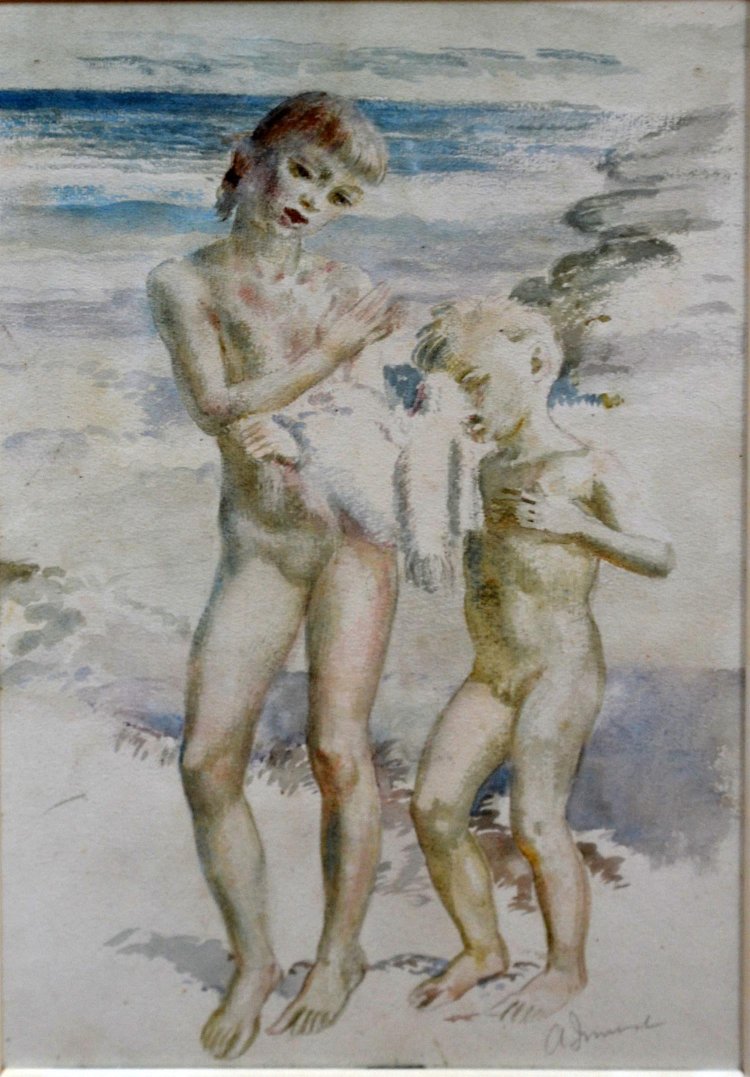 |
Arthur Murch (Australia) 1902-1989
Arthur Murch came from a working-class background and started his working life in an engineering factory. His talents as an artist were soon recognized; he enrolled in art school and in due course won a scholarship to study and work in Europe. (London, Paris and Italy were regarded as essential destinations for Australian artists in those days.) Murch didn't have the financial resources of artists from better-off backgrounds and was often short of funds over there, at one stage drawing portraits for 10/- ($1) each!
WW2 brought him permanently back to Australia where he married and had a stint as a war artist. His reputation was growing, and he won the Archibald Prize (Australia's most famous art prize) in 1949. He and his Ria (Maria) lived on Sydney's magnificent Northern Beaches, and beach scenes such as this one are some of his most famous paintings. "Study of wet children" probably dates from the 1950s, and we can see that the boy is circumcised, as was customary in Australia at that time.
His other works included portraits, murals and sculptures.
 Click the image to enlarge. Use the Back button of your browser to return to this page. Click the image to enlarge. Use the Back button of your browser to return to this page.
|
Salvador Dali (Spanish/Catalan) 1904-1989
Salvador Dali was a living legend, surreal in both his art and his life. This 1954 painting "Two Youths" is (as one might expect) enigmatic. On the left, a circumcised youth lies down and gazes at the standing figure of a (dead?) faceless youth (who seems to have a phimotic foreskin). Dali had an older brother, also Salvador, who died before he was born. Salvador jnr. was consciously conceived as a replacement for his late brother, and his father insisted he was his brother's reincarnation. Is this Dali being visited by his late brother? If so it can't be literal since Dali had dark hair.
 Click the image to enlarge. Use the Back button of your browser to return to this page. Click the image to enlarge. Use the Back button of your browser to return to this page.
|
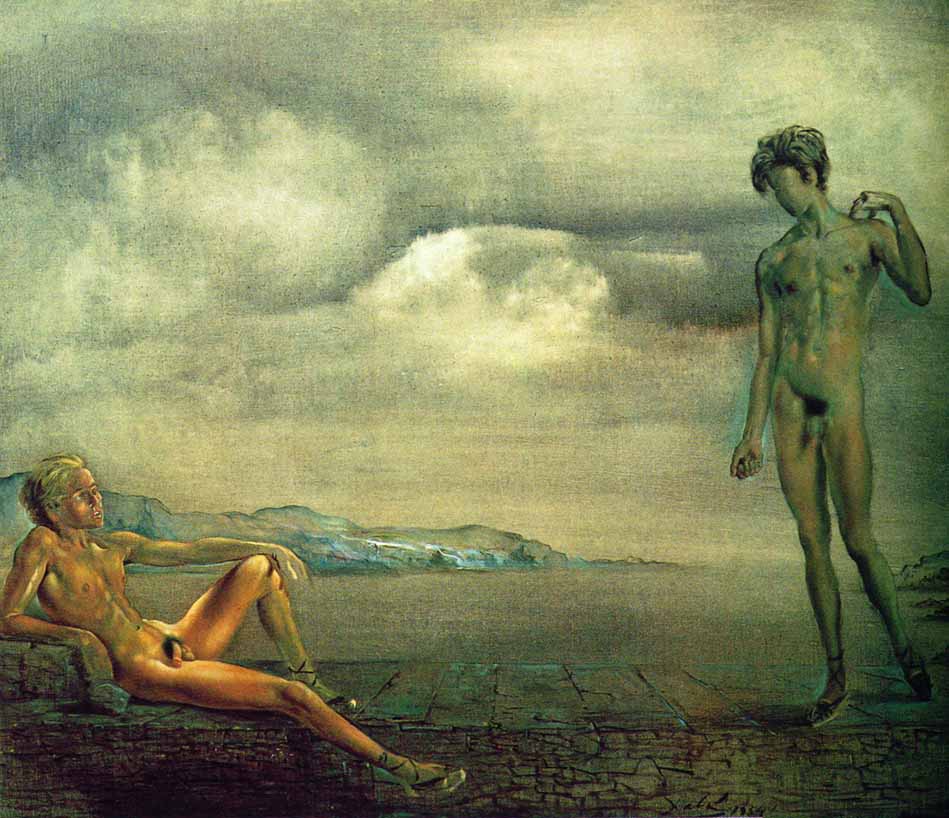 |
 |
|
Justin O'Brien (Australia) 1917-1996
O'Brien was a deeply religious artist who naturally depicted biblical men and boys as circumcised. This included angels, as we see in this painting of Tobias struggling with the angel. (In his time as a teacher he often used his pupils at Cranbrook School as models, and they would have been circumcised, of course). He spent much of his time in Italy and Greece, and the spectacular scenery of Greek island of Skyros features in many of his paintings.
For much of his lifetime the major state collections ignored him yet his exhibitions were sell-outs, with huge queues lined up before opening. (Back then, unlike today, galleries didn't sell pictures prior to the opening of the exhibition).
 Click the image to enlarge. Use the Back button of your browser to return to this page. Click the image to enlarge. Use the Back button of your browser to return to this page.
|
Lucian Freud (UK) 1922-2011
Freud was the grandson of Sigmund Freud, and thus Jewish. He fled his native Germany in 1933 and became one of Britain's nost famous artists of the 20th century. He painted people as they were, and in Britain of those days men were often circumcised. His pictures look spontaneous but in fact they took weeks to produce and he was very demanding of his sitters. He once painted out supermodel Jerry Hall's face because illness forced her to miss two sittings! Not surprisingly most of his models were friends rather than famous.
Copyright restrictions prevent us posting his paintings on Circlist but you can see a picture of his friend Leigh Bowery here. (Opens in new window/tab).
James Gleeson (Australia) 1915-2008
Gleeson was Australia's leading exponent of Surrealism. Many of his paintings show nude men (mostly circumcised) in an imaginary psychological landscape.
This one is titled 'Man in Psychoscape'.
 Click the image to enlarge. Use the Back button of your browser to return to this page. Click the image to enlarge. Use the Back button of your browser to return to this page. |
|
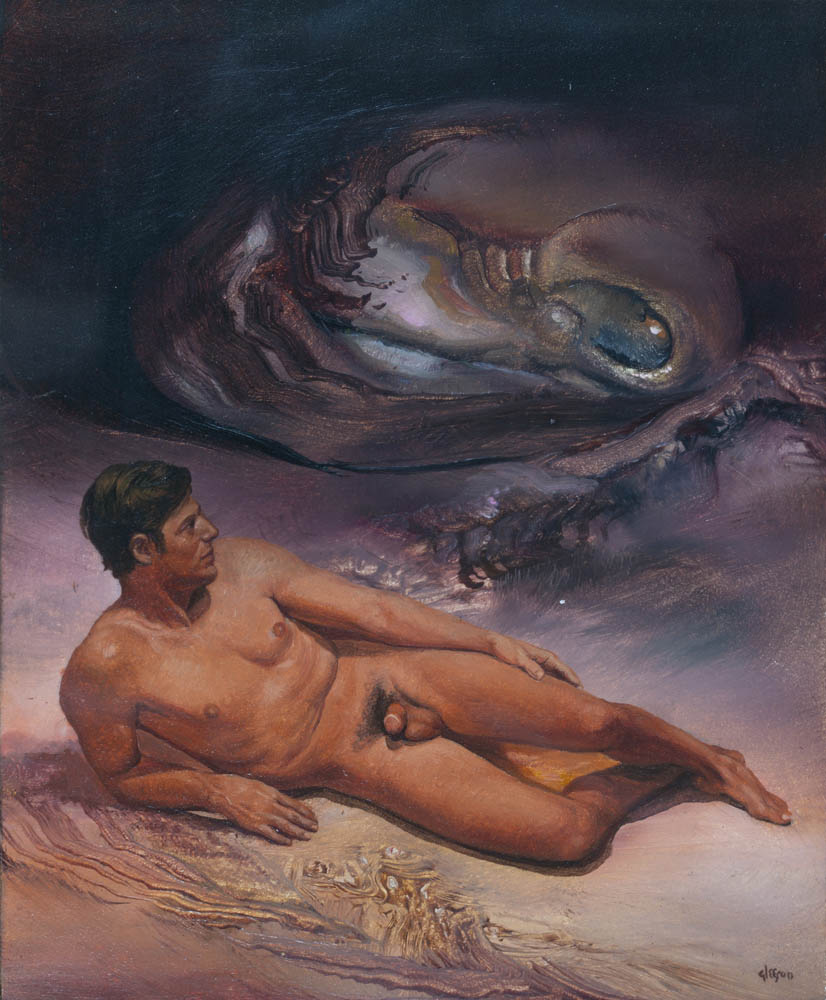 |
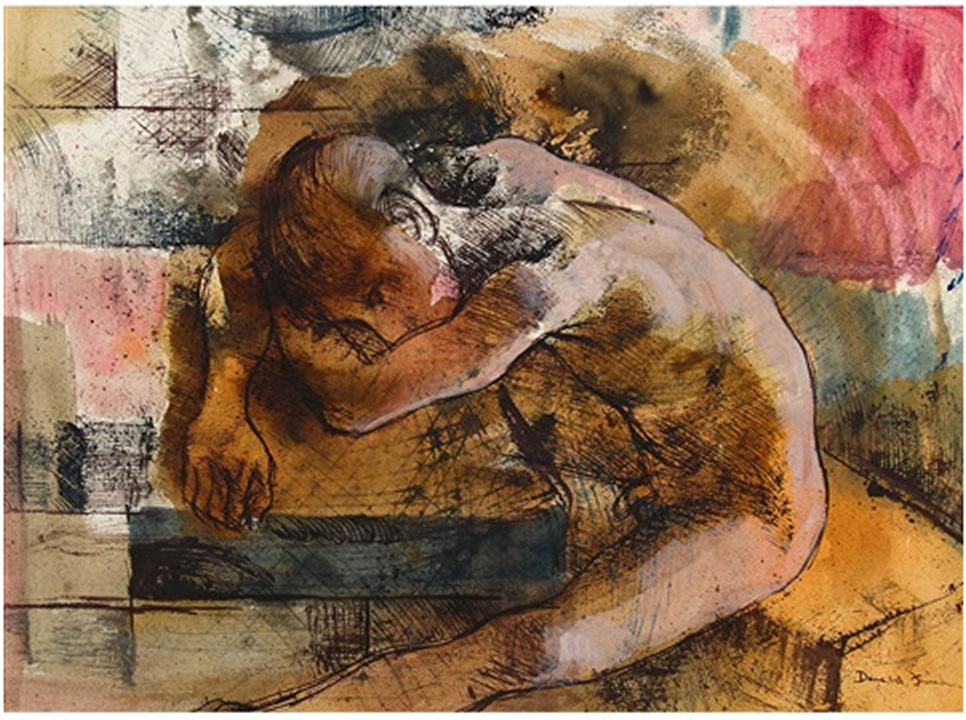 |
|
Donald Friend (Australia), 1915-1989.
Friend spent much of his time outside Australia, most famously at Batujimbar in Bali, where he lived like a lord and entertained the rich and famous. However this is obviously an Australian painting and probably dates from the early 1960s, judging by the style. Amusingly, the pose is a reprise of one he used for a portrait of Rolando, an Italian teenager who often posed for him in 1949 & 1951. But Rolando had a foreskin.
 Click the image to enlarge. Use the Back button of your browser to return to this page. Click the image to enlarge. Use the Back button of your browser to return to this page. |
Noel Counihan (Australia) 1915- 1986
A lifeloong Communist, Counihan worked in a 'Socialist Realism' style, but unlike the Russian images of happy workers, he saw it as his task to depict those downtrodden and suffering under capitaliam. This picture 'The White Cell' dates from 1979 but I have no inforamtion on the story behind it. Unlike the UK, circumcision had no connection with social class so his working classs victim is circumcised as a matter of course. Thanks to DB for bringing this painting to out attention.
 Click the image to enlarge. Use the Back button of your browser to return to this page. Click the image to enlarge. Use the Back button of your browser to return to this page. |
|
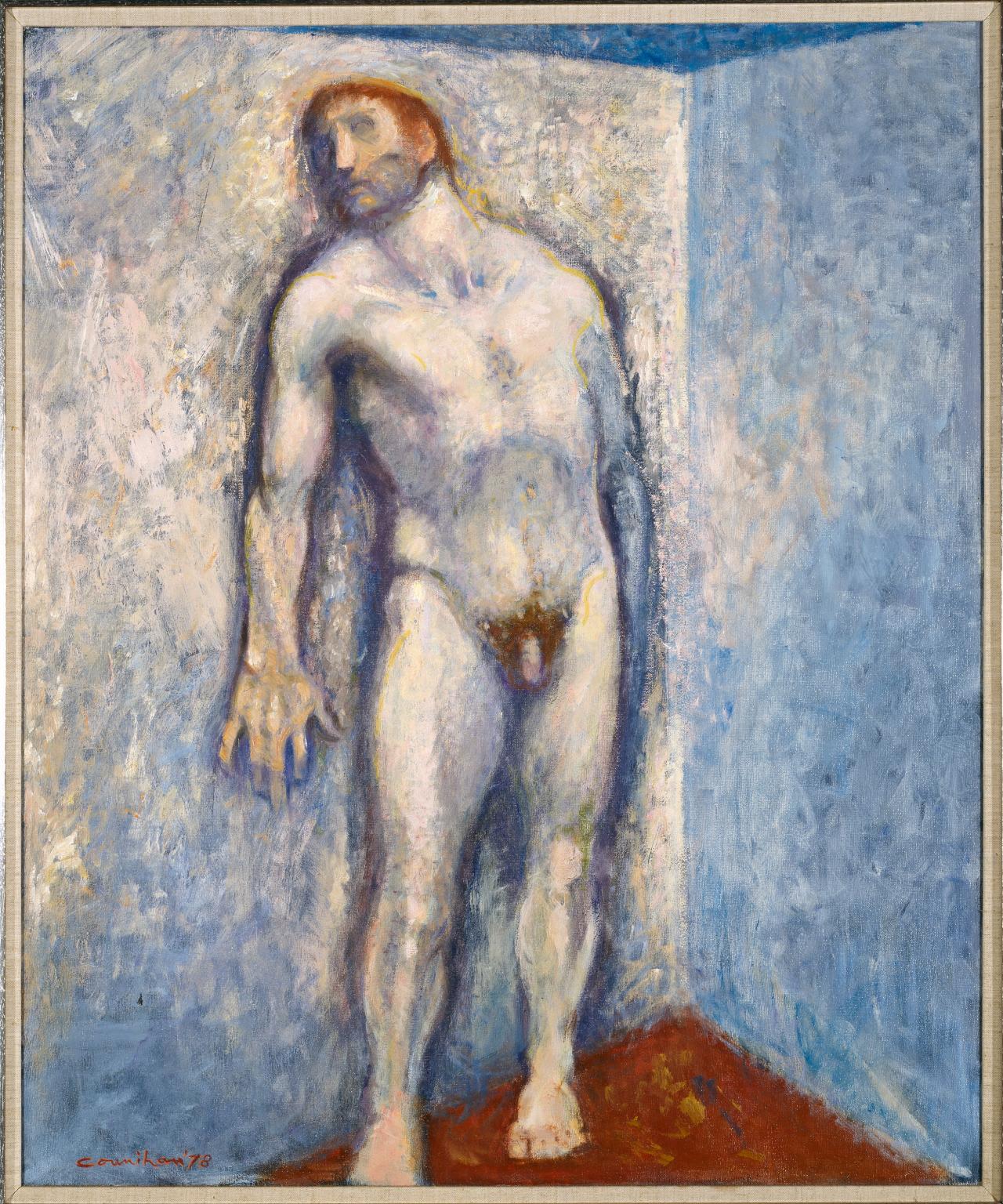 |

|
|
Andy Warhol (USA) 1928-1987
Detail of Warhol's one-off screenprint "Torso (Double) of 1982. Warhol needs no introduction but explicit images like this are rare in his work. The man is clearly circumcised, but quite loosely.
 Click the image to enlarge. Use the Back button of your browser to return to this page. Click the image to enlarge. Use the Back button of your browser to return to this page. |
William D. Hughes (Australia) born 1935
This tender pencil drawing dates from 1975, a time when Hughes was quite well known, with regular exhibitions at a major Sydney gallery. He painted landscapes, street scenes in old Sydney, and especially the 'young Australian male', as the catalogues put it. I can find no mention of him after the 80s, and have no idea if he is still alive. Note the typical Aussie dead-tight circumcision.
 Click the image to enlarge. Use the Back button of your browser to return to this page. Click the image to enlarge. Use the Back button of your browser to return to this page. |
|
 |
 |
|
Joan Semmel, born 1932, is an American painter who started off as an abstract expressionist. She switched to figurative painting with a strong feminist slant after living in Spain for some years during the Franco regime. Her paintings are very erotic but the women are never passive. This post-coital picture, Intimacy-Autonomy, is in the Brooklyn Museum of Art. The man - her lover - has a nice tight circumcision. The woman is Semmel herself. Thanks to Eric W. for bringing the picture to our attention.
 Click the image to enlarge. Use the Back button of your browser to return to this page. Click the image to enlarge. Use the Back button of your browser to return to this page. |
Robert Graham (Mexico - USA) 1938-2008
Robert Graham was born in Mexico but his father died when he was 6 and then his extended family moved to California. He studied sculpture in San José. His sculpture practice was figurative and the nude body featured strongly in his work. He had exhibitions in the US and Europe but the work which catapulted him to stardom was the 'gateway' to the 1984 Los Angeles Olympic Games. The Games were held in the Los Angeles Memorial Coliseum, originally built in 1923 as a memorial to veterans of WW1. It hosted the LA Olympics in 1932 and again in 1984. For the 1984 Games Graham was commissioned to create a new ceremonial gateway. His design was topped by nude torsos of two athletes, one male, one female (and one black, one white but you can't tell that from the bronze).
 Click the image to enlarge. Use the Back button of your browser to return to this page. Click the image to enlarge. Use the Back button of your browser to return to this page.
|
 |
The model for the female torso was Jennifer Innis, born in Guyana, Olympic sprinter and long jump competitor. She competed in in 1980 in both sports, but in 1984 she only competed in the long jump. The male model was Terry Schroeder, water polo player (and chiropractor in private life). As we can see, he is clearly circumcised. The explicit nudity of these sculptures has caused controversy. A commemorative silver dollar coin (also designed by Graham) featuring the Gateway was struck for the Olympics but president Ronald Reagan insisted that it must only show the rear view. No naughty bits on US currency!
That wasn't the end of it. In 1996 The US leg of the torch relay started at the Memorial Coliseum to run to Atlanta. It was proposed to either drape the sculptures or fit them with fig leaves for the occasion. Fortunately public outcry meant that sanity prevailed.
Thanks to JH for alerting us to this.
 Click the image to enlarge. Use the Back button of your browser to return to this page. Click the image to enlarge. Use the Back button of your browser to return to this page. |
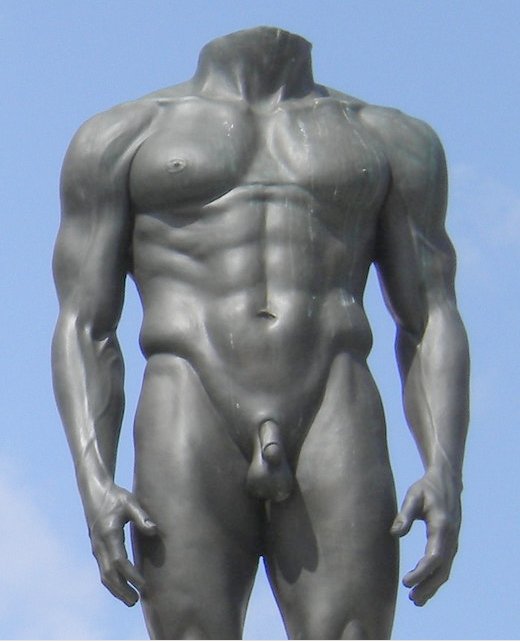
|
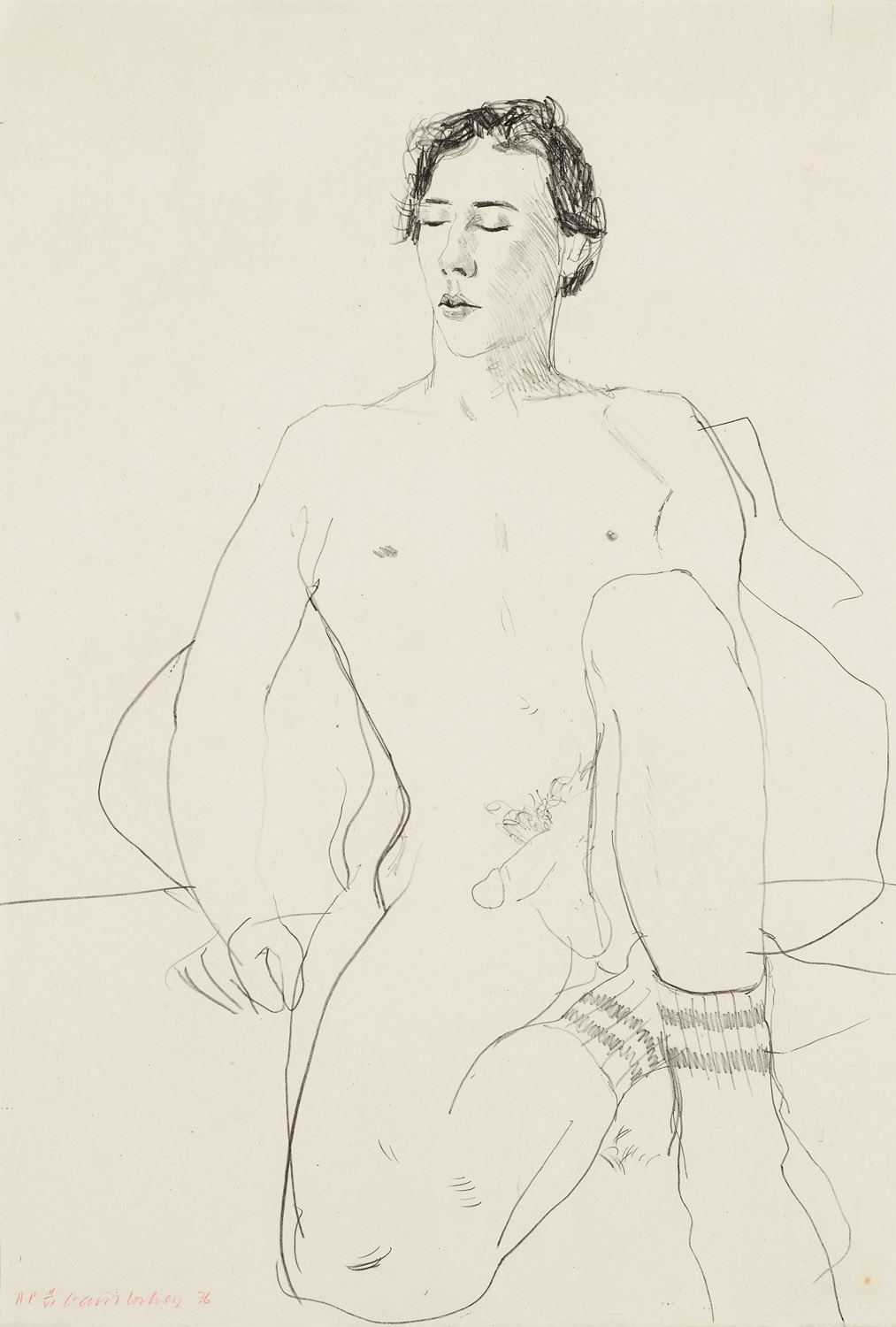 |
David Hockney (British - USA) born 1937
 Click the image to enlarge. Use the Back button of your browser to return to this page. Click the image to enlarge. Use the Back button of your browser to return to this page.
David Hockney was born in Bradford, UK but found his feet as an artist in California in the 1950s and 1960s. His swimming pool paintings are iconic. Needless to say the young men he drew and painted were all circumcised. and this is a beautiful example. Gregory Evans was his second Californian lover and long-time business associate after that
Later he returned to Yorkshire and painted some wonderful rural scenes. That came to an end after an unfortunate incident when a young, drunk and stoned, studio assistant died after swallowing drain cleaner. The inquest verdict was misadventure but it hit Hockney hard and he sold his Bridlington, Yorkshire, property. He has homes in London and California but in 2020 moved to a farmhouse in Normandy to escape Covid.
He remains one of the world's most highly priced living artists, vying for top spot with Jeff Koons - who also appears on this page.
|
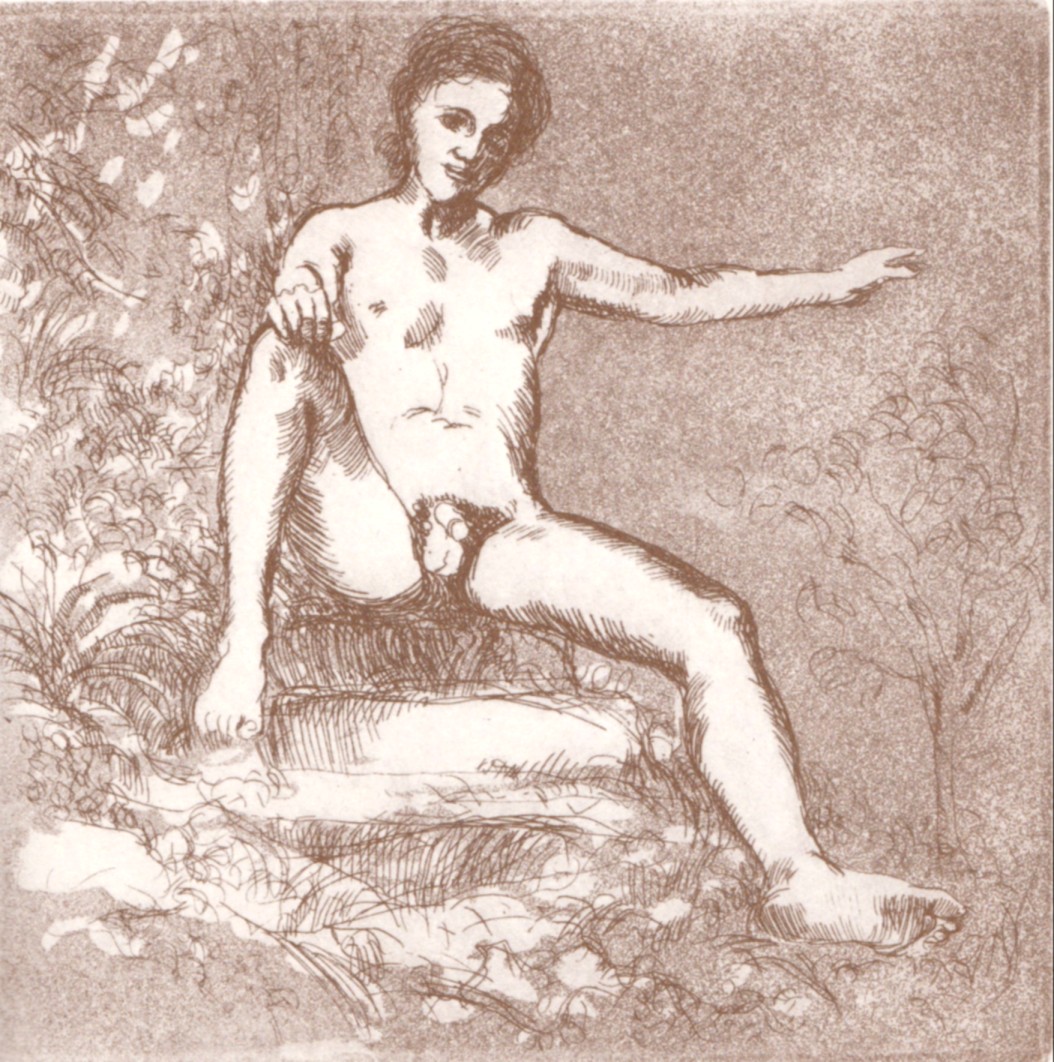 |
Paul Delprat (Australia) born 1942
Paul Delprat is the current director of the Julian Ashton Art School, Australia's oldest art school - and a direct descendant of the founders. He is also a (much prized) eccentric. After a spat with the local council he declared independence, founding the Principaliy of Wy. The mayor was clearly on his side and held a ceremony granting independence!
His pictures are often somewhat erotic and men and boys are always circumcised. The left image is an etching entitled Apollo 1, from 1975. One might think that this belongs on our "Quirky" page but clearly it really isn't intended to depict the Greek god, it's just a fun title for an image of a good-looking teenager. One sees what I suspect is the same young man, a few years older, in "Youth and Rider" from 1981 (right), now with a girlfriend.
 Click either image to enlarge. Use the Back button of your browser to return to this page. Click either image to enlarge. Use the Back button of your browser to return to this page.
|
 |
Neil Moore (Australia) born 1950
Neill Moore was born in England but his family moved to Australia in 1952. He now lives in Italy with his family, but still exhibits in Australia (and elsewhere). He worked as a cartoonist and caricaturist for various newspapers before deciding to devote himself exclusively to fine art. Fallen Icarus (1997) could maybe belong on our Quirky Circumcision page in that it depicts the tragic Cretan hero as circumcised, but it is clearly more of a modern allegory than a classical illustration.
Moore painted several versions of this theme and we have a detail image from a slightly different version. From the low and dead tight circumcision the model must be Australian.
Images sourced by MS
 Click the image to enlarge. Use the Back button of your browser to return to this page. Click the image to enlarge. Use the Back button of your browser to return to this page.
| |
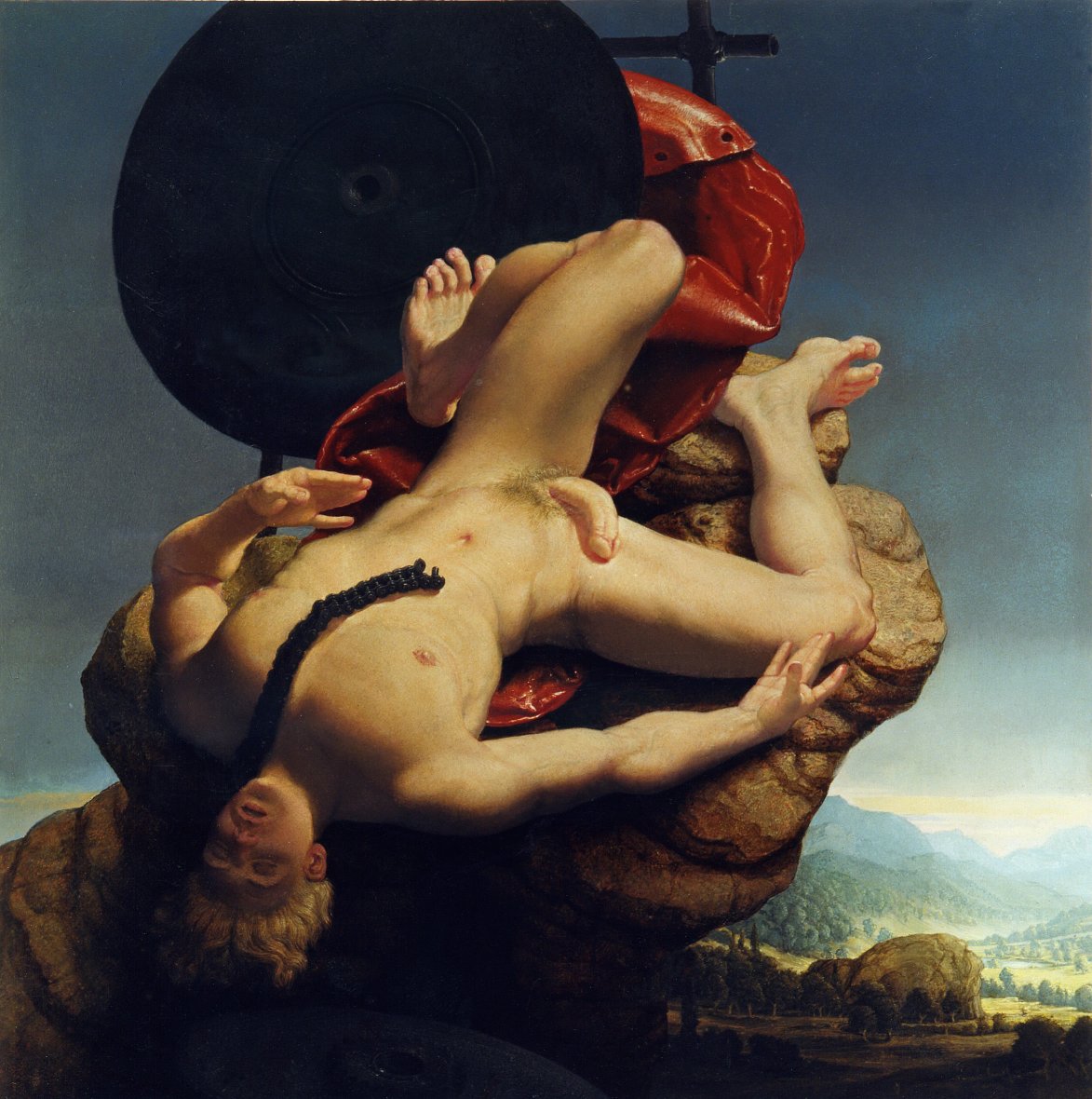 |
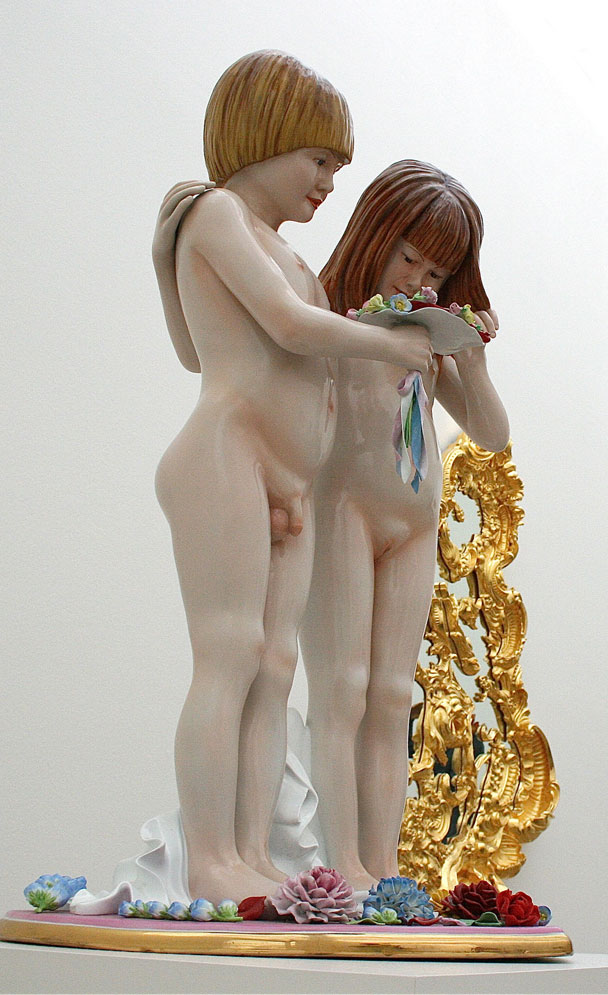 |
Jeff Koons (America) born 1955
Naked, 1988 - a porcelain sculpture by American Pop artist Jeff Koons, who is best known for his 'balloon dogs'. This has particular interest since it was advertised in the publicity for a Koons retrospective at the Centre Pompidou in Paris. Here it was spotted by the widow of the photographer Jean-François Bauret, who spotted a startling resemblance to her late husband's photograph 'Enfants' taken in 1970, and issued as a postcard in 1975. (See the comparison below.) The children look identical even down to the hairstyles.
Mme Bauret complained to Koons and the Pompidou, who took no notice, so she took them to court, and in March 2017 she won. The judges noted that there differences - notably that Koons has the boy handing the girl a flower, whereas in Bauret's work they are just holding hands. Whether they also noted that Koons' boy is circumcised and Bauret's is not was not recorded. The damages were €44,000 - just a slap in the wrist for Koons, whose works sell for millions, but probably useful for Mme. Bauret, even though half was taken up by legal fees.
Koons is no stranger to copyright suits - this was his second in a month! He loses most of them but when the penalties are so trivial, why should he care?
 Click the image to enlarge. Use the Back button of your browser to return to this page. Click the image to enlarge. Use the Back button of your browser to return to this page. |
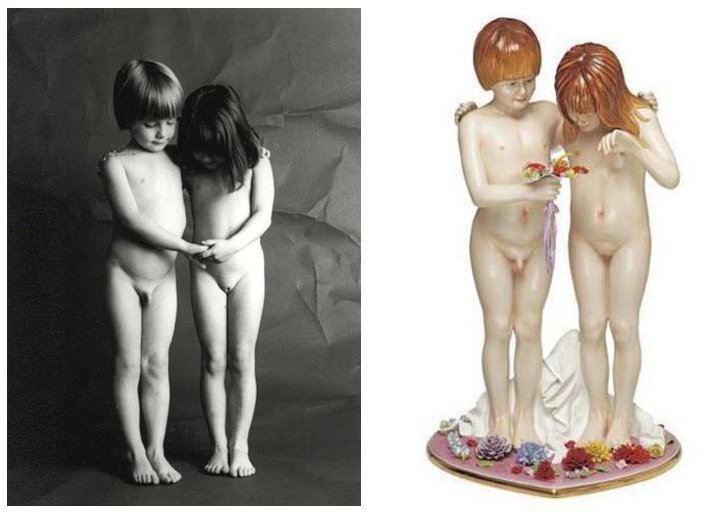
Helen Facenna (UK) contemporary
Sunday Afternoon, by Helen Facenna (pronounced Fachenna). She doesn't give her age but does list Lucian Freud (see above) as one of her greatest influences, and that influence is obvious here. MS, who supplied the image, writes:
She has executed a number of pictures of nude men, with most of the frontal views showing circumcised penises. Very unusal to find so many cut models in the UK! Does it reflect her own preference? I must say the pictures scream American influence to me and wonder if she has worked there.
Well, she describes herself as working in the UK, but she does seem to be influenced by US porn! However she paints and sculpts a wide range of other subjects too. See her page in Deviant Art.
 Click the image to enlarge. Use the Back button of your browser to return to this page. Click the image to enlarge. Use the Back button of your browser to return to this page.
|
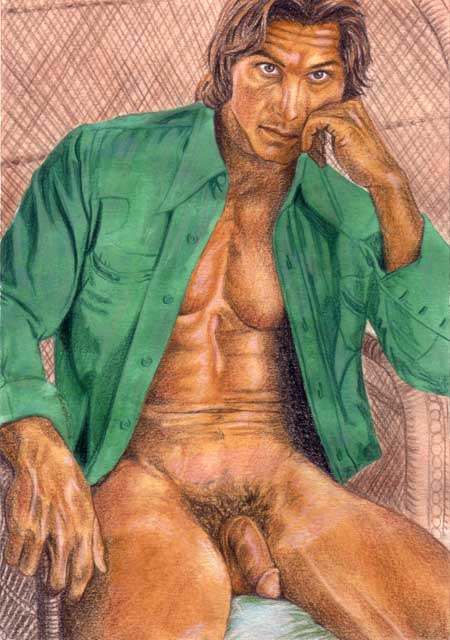 |
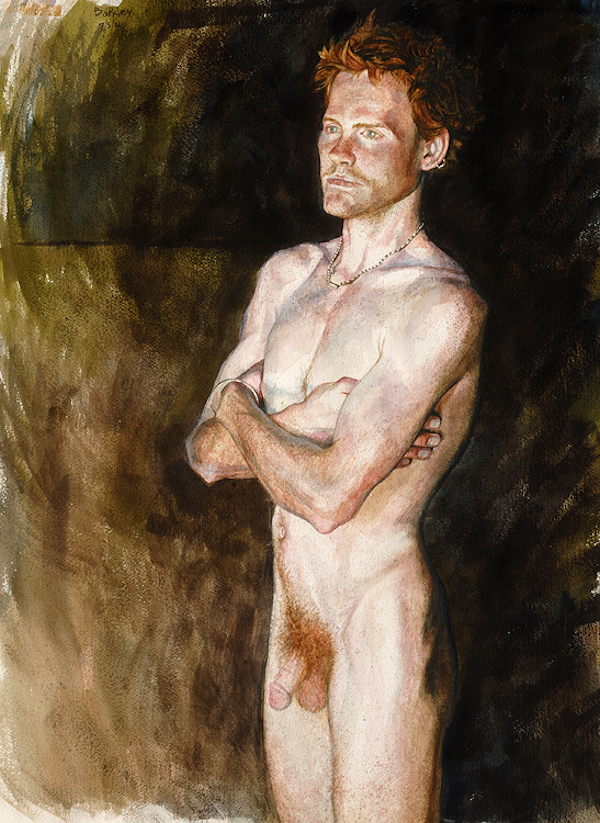 |
Daniel Barkley (Canada) born 1963
Grant, arms crossed, is one of three standing portraits the Montreal artist painted of this young man in 2000. Barkley has won many awards in Canada, and had major retrospectives in 2004 and 2007.
It is good to see that circumcision still rules in Canada, and in this case at least, high and tight.
 Click the image to enlarge. Use the Back button of your browser to return to this page. Click the image to enlarge. Use the Back button of your browser to return to this page. |
| |
Norbert Bisky (Germany) 1970-present
Born in Leipzig (Germany) in 1970, Norbert Bisky studied at Universität der Künste, Berlin. He became particularly famous for his paintings of boys and young men. In a way, his style can be seen as a modern paraphrase of the depiction of the typical "ideal German youth", so popular during the Nazi era and later in GDR propaganda. We see lots of tall, blonde, healthy, often half naked young men engaged in some sports or other group activity. Some of the titles of his works speak for themselves to express the manly and collective character of those activities (but see editor's comment below).
 Click the image to enlarge. Use the Back button of your browser to return to this page. Click the image to enlarge. Use the Back button of your browser to return to this page.
|
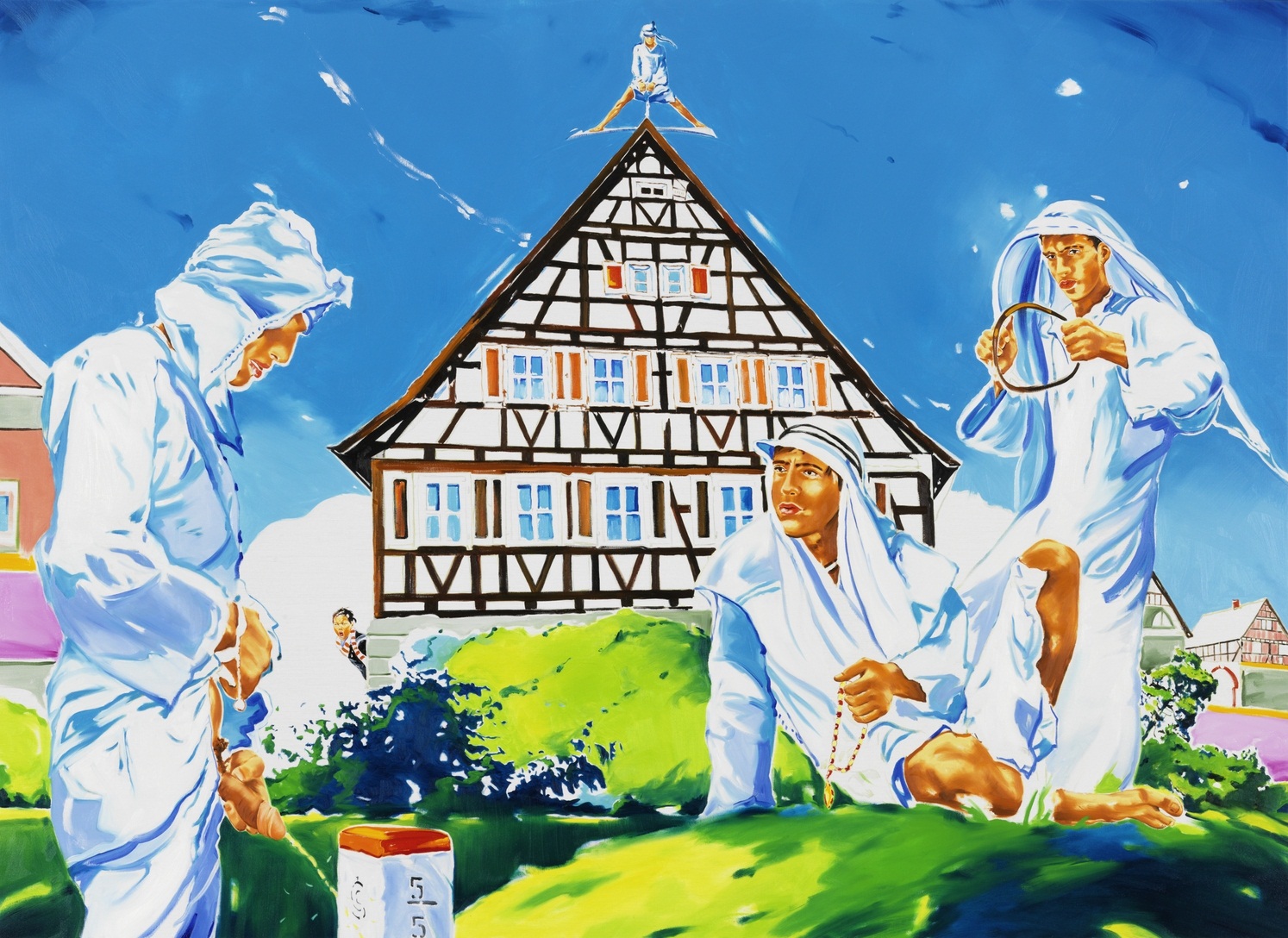 |
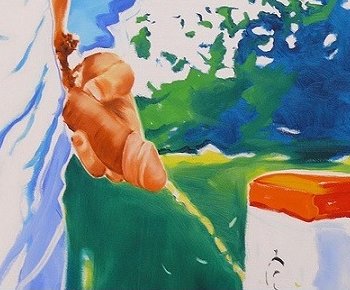 |
One painting however is of special interest to the readers of Circlist: Michelsdorf (2007). While the majority of the models in Bisky's other paintings are white, this one shows a group of young men of (clearly) Arab (Muslim) descent. While in other paintings we see boys and young men clothed or shirtless, this one leaves nothing to the imagination about details of the male anatomy of a more intimate nature. Note the various reactions of the bystanders to the obviously circumcised member of the boy.
More about the work by Bisky can be found on his website or for instance in the book Norbert Bisky: A Retrospective, 10 Years of Painting.
Article by Arend.
Editor's note: My take on Bisky's pictures of 'ideal German youth' is that they are homo-erotic parodies of the Socialist Realism style. Remember East Germany had its first democratic elections, and opened its borders, when Bisky was 19. Reunification followed the next year. Anyway, have a look at his picture Auf der Wiese, Alarm in Baikonur and decide for yourself.
|
Charles Ray (USA) born 1953
In 2009, the American sculptor Charles Ray caused a bit of a stir in Venice, Italy, by unveiling a commissioned statue ‘Boy with Frog’ depicting a circumcised boy. The same theme has previously been sculpted in bronze by another American, Edward Henry Berge (1876‒1924) but the boy wasn't circumcised and the art was nothing like the same quality. Charles Ray’s version formerly stood at the entrance to the Grand Canal. It was subsequently moved because its popularity caused major congestion!
 Click the image to enlarge. Use the Back button of your browser to return to this page. Click the image to enlarge. Use the Back button of your browser to return to this page. |
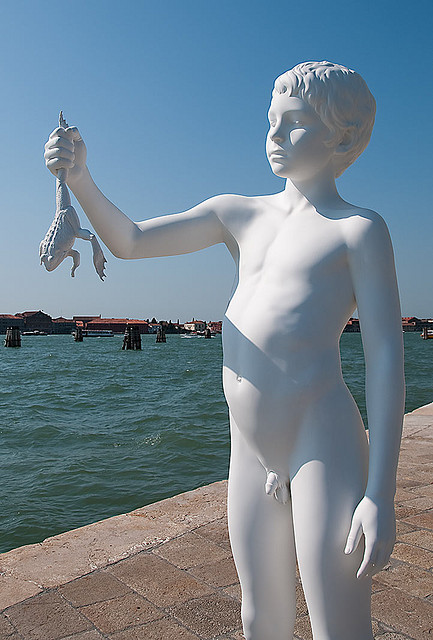 |
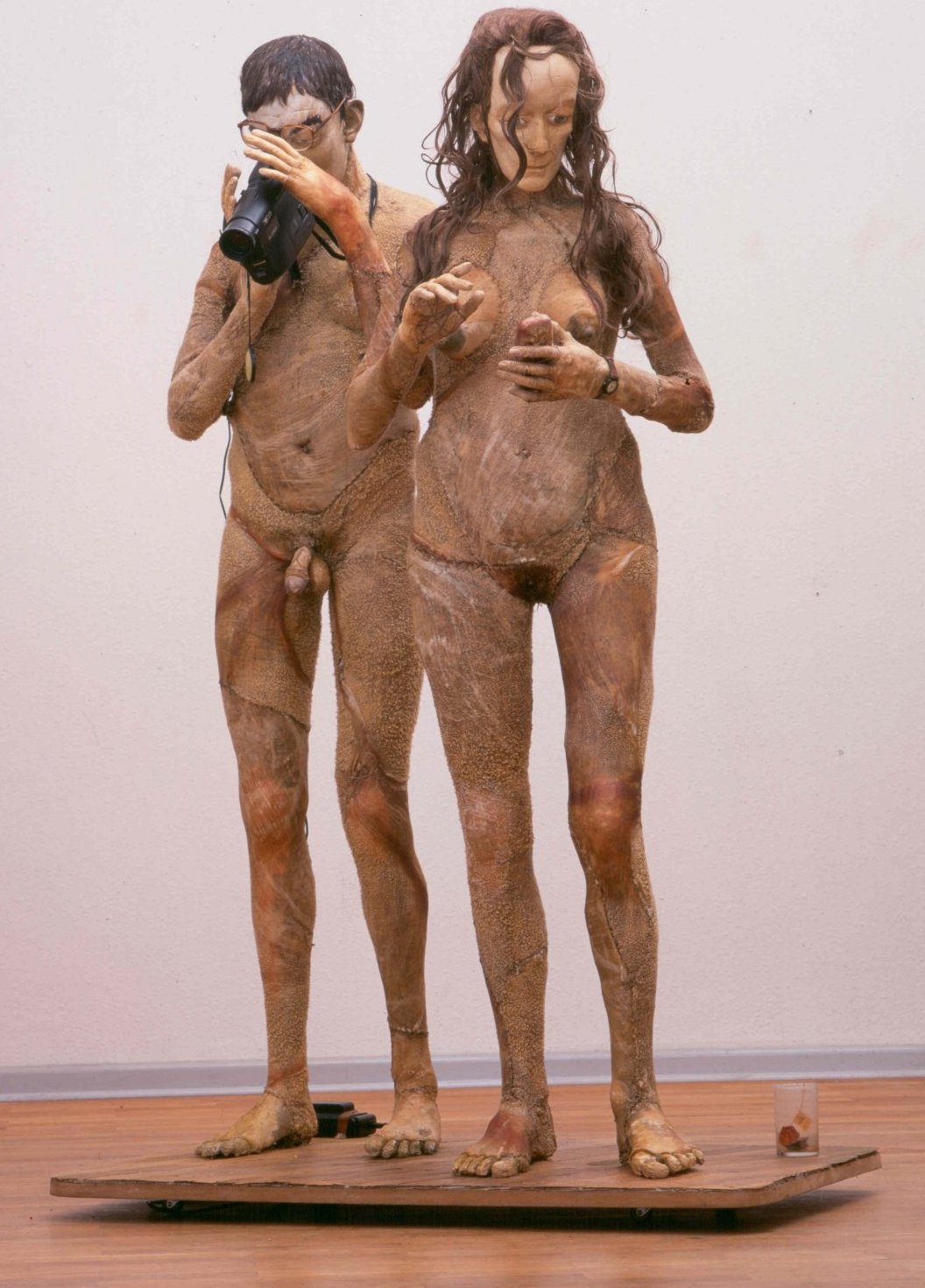 |
Paweł Althamer (Poland) born 1967
Althamer is a leading Polish sculptor, ceramicist and installation artist. This 2002 sculpture depicts him with his then wife Monika. But is he circumcised or just naturally uncovered?
If the latter, it seems to be even rarer than circumcision in Western art.
 Click the image to enlarge. Use the Back button of your browser to return to this page. Click the image to enlarge. Use the Back button of your browser to return to this page. |
Loribelle Spirovski (Australia) born 1990
Spirovski is an Australian artist of Filipina/Serbian/Macedonian descent. In August 2021 she won the prestigious (and financially rewarding) Manning Naked and Nude art prize with this portrait of her husband, internationally famous concert pianist Simon Tedeschi.
Has any other musician of comparable stature allowed himself to be publicly shown in the nude? I cannot think of an example. Simon Tedeschi has a Jewish mother but whether he identifies as Jewish I don't know. He was born in 1981 when circumcision was still common in Australia. Congratulations to both Loribelle for her prize and Simon for being bold enough to let himself be portrayed in the nude. Image courtesy Nanda-Hobbs gallery which represents Spirovski.
 Click the image to enlarge. Use the Back button of your browser to return to this page. Click the image to enlarge. Use the Back button of your browser to return to this page. |
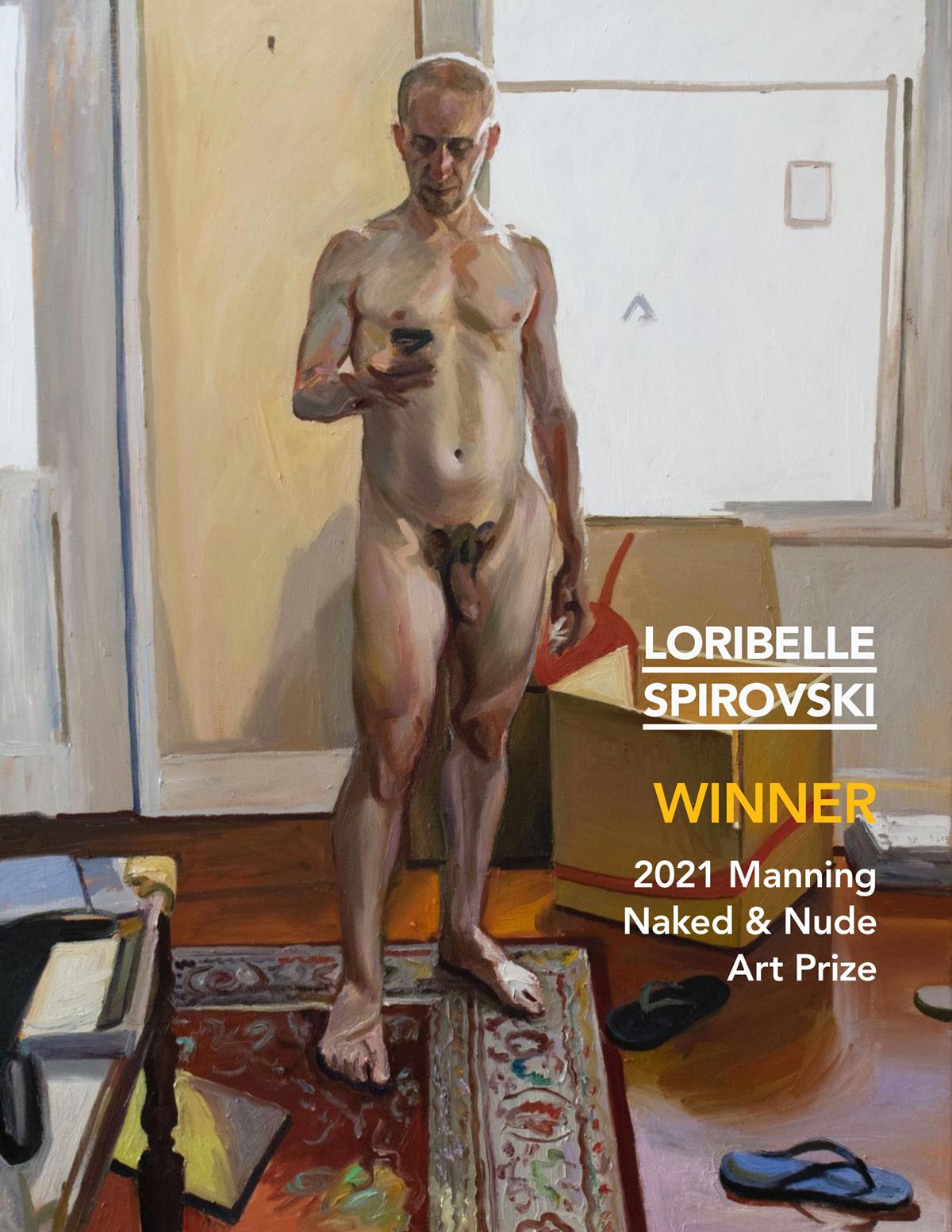 |
For further images of circumcision in art go to our Quirky Circumcision page,where we explore images that are in some way unconventional. Circumcised Greek Gods? Was Adam circumcised? Explore the possibilities - all are great art.
Further suggestions welcome
To suggest further examples of circumcision depicted in artworks please e-mail the Editor.
 Click here to e-mail a suggestion to the editor.
Click here to e-mail a suggestion to the editor.
Acknowledgements
Thanks to Tom, Eric, Alex, JM, Artsy magazine, the British Museum and the Tate Gallery for images and links and to the Royal Academy, the Art Gallery of NSW and Wikipedia for information.
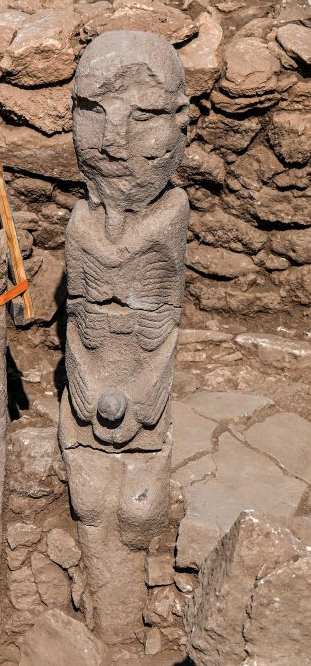
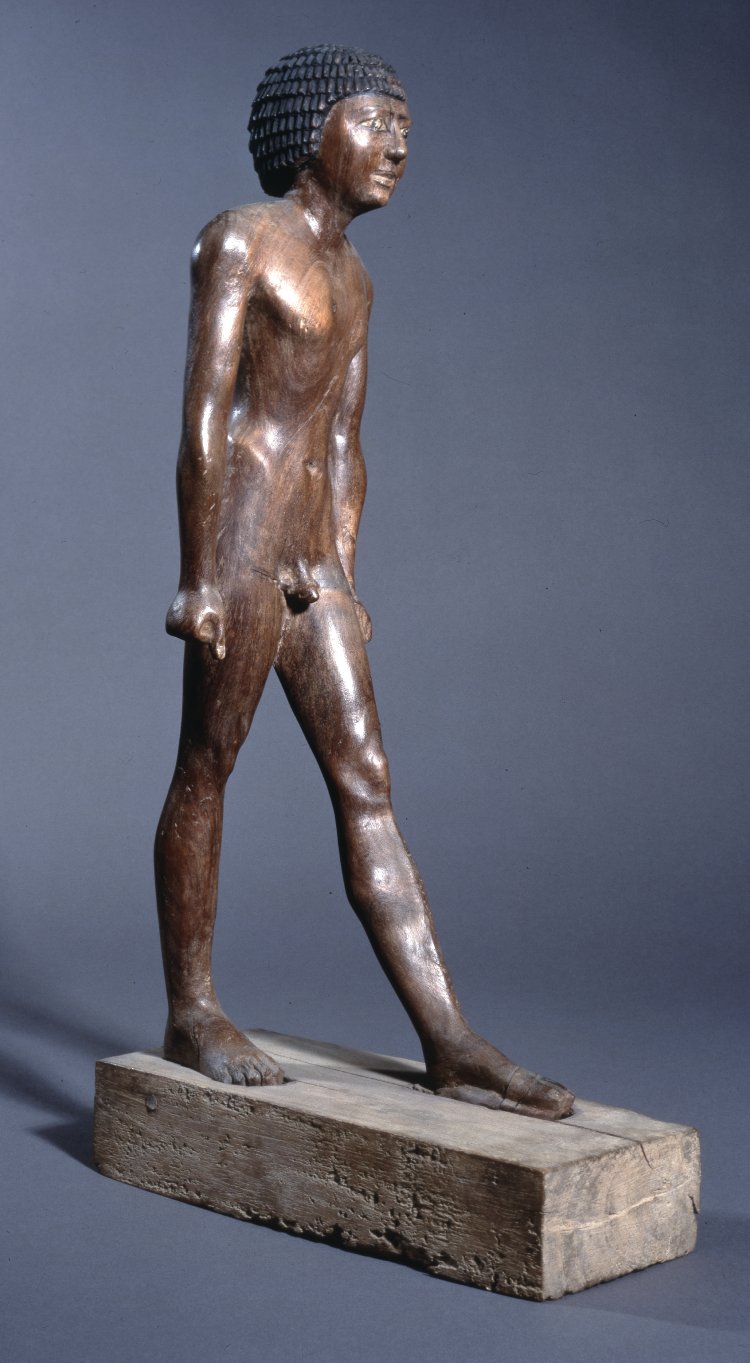
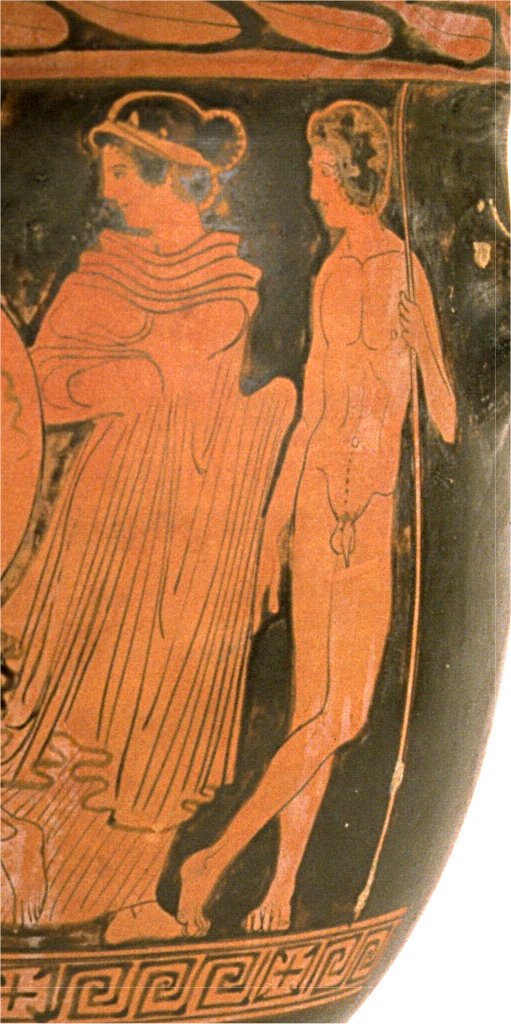
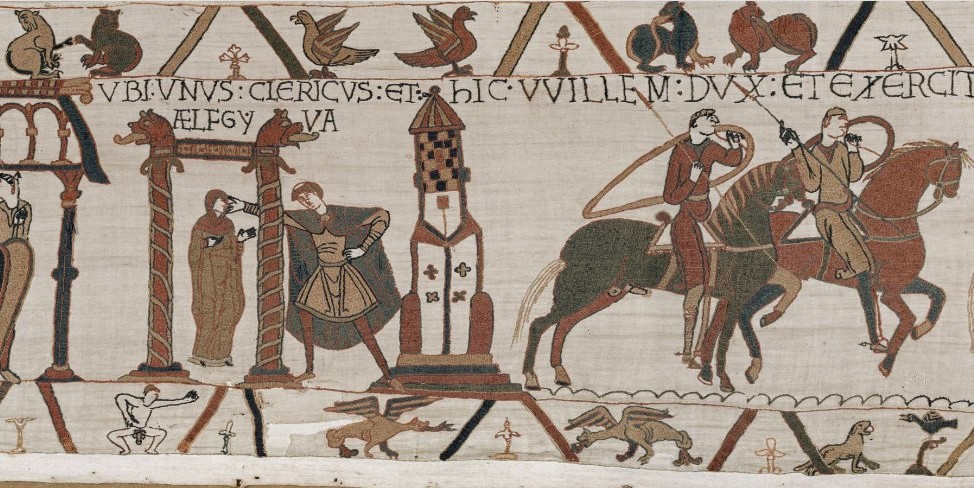
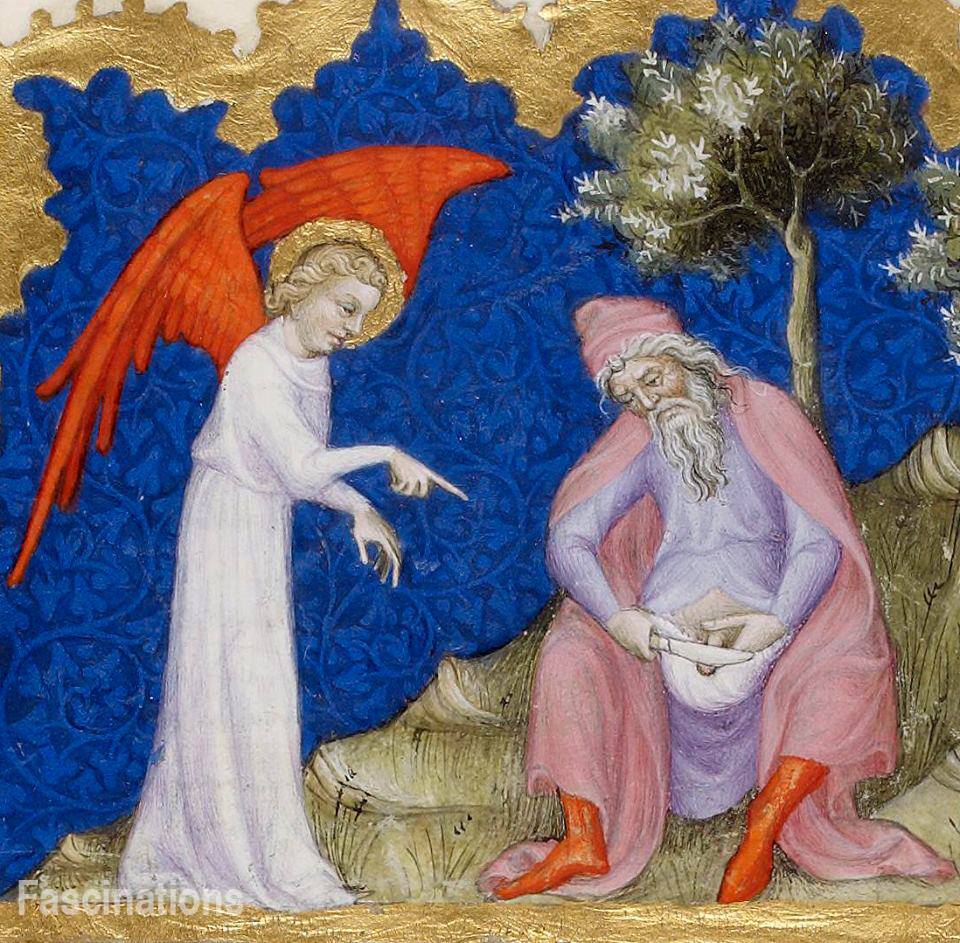



 We are lucky to be able to see Adam's private parts - before cleaning in the 1980s they were hidden by added vegetation (not actually fig leaves), shown left. The angel's severe expression was also toned down (shown right) before the cleaning revealed Masaccio's original version.
We are lucky to be able to see Adam's private parts - before cleaning in the 1980s they were hidden by added vegetation (not actually fig leaves), shown left. The angel's severe expression was also toned down (shown right) before the cleaning revealed Masaccio's original version. 






